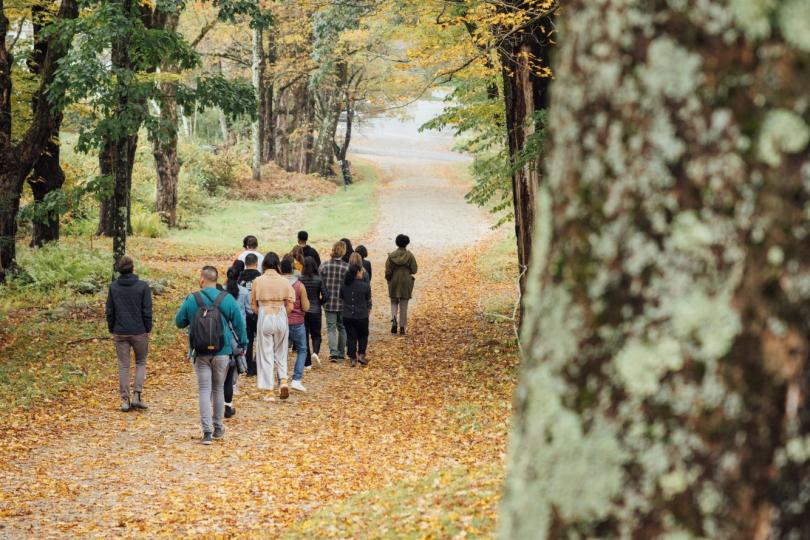Demystifying the fellowship selection process
Written by Maya Higgins
“In a gift economy, wealth is understood as having enough to share, and the practice for dealing with abundance is to give it away. In fact, status is determined not by how much one accumulates, but by how much one gives away. The currency in a gift economy is relationship, which is expressed as gratitude, as interdependence and the ongoing cycles of reciprocity. A gift economy nurtures the community bonds that enhance mutual well-being; the economic unit is “we” rather than “I,” as all flourishing is mutual.”
― Robin Wall Kimmerer, The Serviceberry: Abundance and Reciprocity in the Natural World
Before I (Maya) came to work at the Switzer Foundation, I had heard about the Switzer Fellowship. I did not pursue a graduate degree in New England or California, so I never seriously considered applying, but I had met numerous Switzer Fellows throughout my work over the years. Each fellow that I met was their own unique individual and yet, they were all equally amazing in their passion for shaping the world to be a more just, sustainable, and vibrant place. They each struck me with their kindness and generosity of spirit. Through these interactions, I wondered, what goes into the selection of a Switzer Fellow?
When I began working as the Program Manager here last April, I worried about my ability to select a cohort of fellows from such an inspiring and competitive applicant pool. Quickly I realized that my worry was not necessary because I would not actually be the person who selected Switzer Fellows. In fact, there is no one person. The Switzer Fellowship’s selection process, although imperfect and continuously evolving, like any healthy process, is an incredible experiment and testament to what collective and shared leadership can look like at scale (‘when the economic unit is “we” rather than “I”’). This year, almost 100 Switzer Fellows participated in the process of selecting the 2025 cohort of fellows. The people who joined the selection process ranged from our most recent fellows to some from our first cohorts. They spanned geography, sector, and identities, and gathered around what I perceived as a shared goal: to continue to deepen and nurture the strength of the Switzer Network and to welcome new fellows into the community.
It's always incredibly inspiring to hear about the amazing work the candidates are doing. I also enjoy being able to interact with other Fellows and to give back to the Foundation.
2025 Switzer Fellow application reviewer
So how exactly does our selection process work? It is my hope that this post can demystify the process a bit while also celebrating the exceptional generosity, wisdom, and collaboration of the Switzer Fellows who support this process.
Opening Applications
I can’t begin the story of our selection process without highlighting the tremendous amount of labor that our Administrative Coordinator, Laine Kuehn, puts into setting up our online application system, Foundant. I wish I could share details about this piece of the process, but Laine’s wizardry here is honestly beyond me. What I do know is that they support our system where hundreds of applicants (this year we received 226 applications) can upload their information and nearly 100 Switzer Fellows can review select pieces of the application over the course of several months. It is big work and Laine coordinates it beautifully.
First Round Review
In the first stage of our review process, every application is reviewed by two different Switzer Fellows. This year, we had nearly 60 Switzer Fellows volunteer for this first stage review process. Volunteers for this first round of review are not compensated financially because we have heard from the network that fellows feel strongly about the ability to have unpaid opportunities to give back to the Switzer Network. In this stage, volunteer reviewers assess a random assortment of ~8 applications and score them according to the evaluation criteria and rubric (which we share publicly on our website so that it is available to applicants). Once all scores and comments are in, scores are standardized and 80 semi-finalists are selected to move forward in the selection process.
“I absolutely loved serving as an application reader and would love to participate again in the future. It was particularly inspiring to learn about these students and their work while we are going through what is happening at a national level at this time.” ~2025 Switzer Fellow Application Reviewer
Second Round Review
In this second stage of review, two paid consultant reviewers (also Switzer Fellows) are assigned to each region. This review team spends about a month looking at all 40 applications in their region collectively and, using the same evaluation criteria and rubric shared above, selects 20 finalists for their region to move forward to the interviews. Consultant reviewers often serve in this role for a few years before passing the opportunity to another Switzer Fellow.
Interviews
In the final step of the review process, 20 candidates are interviewed from California and 20 from New England throughout the course of two interview days. On each interview day (currently grouped by region), 15 Switzer Fellows conduct interviews on teams of three, with the option to accept a stipend. Each interview team interviews four candidates throughout the course of the day. Adapted from our equity-centered hiring practices, all candidates have 30 minutes for their interview and are asked the same set of questions. As in all stages of review, candidates are assessed according to the same evaluation criteria and rubric used in previous stages. Interviewers work to minimize bias using tools like the Chicago Beyond Mirror Tool and assess candidates independently before discussing the interviews with each other. At the end of the interview day, each interview team collectively scores and ranks their candidates. A Team Leader from each team joins a final selection meeting where the five Team Leads collectively decide on 10 candidates to be awarded a Switzer Fellowship in each region. The interview day is long and often involves compromise since all of the applicants that make it to the interview day are incredible. That being said, these days are also highly rewarding as they result in us having 20 new Switzer Fellows to welcome to the Switzer Network, and what an incredible group of humans those fellows are.
“I loved reviewing applications and meeting the candidates. They were incredibly inspiring. It was invigorating to hear about all the different types of work that are happening to make the world a better place.” ~2025 Switzer Fellow Interviewer
Throughout the application process, the staff and fellows work collaboratively to implement the Switzer Foundation’s commitment to advance equity in environmental leadership and build the Switzer Network as an inclusive community for all leaders to find supportive pathways for success (see our Mission, Vision, and Values for more details). We hold ourselves accountable to this commitment by collecting demographic information about applicants to the Switzer Fellowship. Participation is voluntary and no demographic information is visible to reviewers or used in decisions about individual candidates. Demographic data is viewed in aggregate by Switzer staff to track under- or over-representation of demographic groups throughout the fellowship review, interview, and selection processes so that we can continue to adapt and evolve our approach to meet the foundation’s commitment to expand equity in the environmental field.
Trust and Shared Leadership
Having gone through the full selection process this year, I can say that I am amazed at how well this system works. Coordinating 100 Switzer Fellows to collaborate and select the next cohort of fellows is no small task. It does require a big lift in terms of material preparation, email communication, “office hours” support, and calendar scheduling. That being said, it has also been a small lift in terms of decision-making stress and fatigue.
Throughout this process, I learned that in contrast to a hierarchical decision-making structure where a small group of foundation staff, trustees or fellows hold all the power in making selection decisions, distributing power and influence among such a large group of Switzer Fellows actually allows for more autonomy and collaboration in decision-making. It increases capacity and invites us all into a practice of trust. Namely, trusting other fellows in other parts of the process to also make good decisions. It allows us to invite feedback and dialogue throughout the process. This ongoing dialogue supports shared leadership and iteration that focuses on improving the overall collective process rather than silently following the lead of a single powerful individual. In short, we are better as a collective and our small staff team can accomplish so much more with the support and collaboration of so many throughout the network.
As the selection season wraps up, I am buoyed by gratitude for our fellows. I truly enjoyed working alongside you as you did the hard and important work of selecting new fellows to join the network. I’m looking forward to learning more and continuing to evolve this process as we start the selection process again this winter and continue to expand our Switzer Network. To our new fellows, I’m excited to have you join us in this process and I am confident that your voices and decisions will contribute to the continued evolution of our shared work of selecting and supporting incredible cohorts of Switzer Fellows. Welcome.

